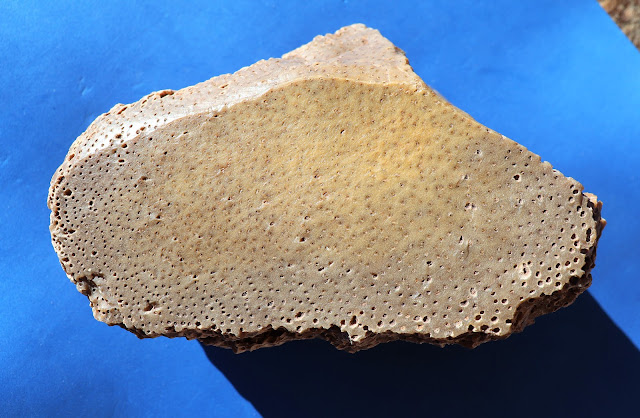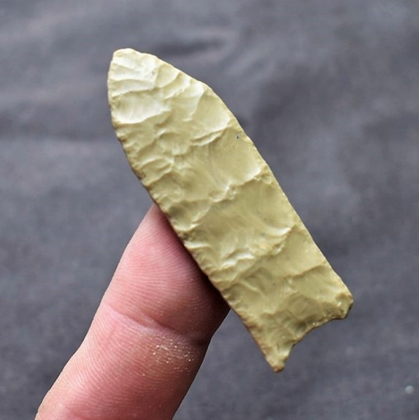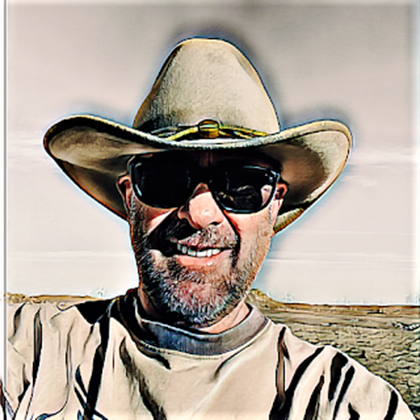by John Bradford Branney
 |
| Figure One - Artifacts from the author's collection, made from various flavors of Alibates agatized dolomite. Tear-drop ultrathin knife form to the right is 3.25 inches long. |
 |
| Alibates National Monument around Lake Meredith. Graphic by Jason Kenworthy (NPS Geologic Resources Division). |
 |
Figure Two - Boulders of white Alibates Dolomite cascading down hills at Alibates Flint Quarries NM. NPS Photograph.
|
How
did the name Alibates agatized dolomite come about? Gould (1907) first described the agatized dolomite a mile and a half
south of the national monument along Alibates Creek in Potter County, Texas. A
local rancher named the creek after his cowboy son, Allen “Allie” Bates, and
Gould named the rock type after the creek where he found it. Agatized is an
adjective describing the geological process that creates the rock type called agate,
which is a striped or banded, sometimes translucent, cryptocrystalline variety
of quartz. And the last word in the rock type’s description, dolomite, is a
common, rock-forming mineral that I will discuss later in the article.
Barnum
Brown did not agree that the rock samples Gould sent him were agatized dolomite. Brown
believed the rock samples were jasper, a variety of chert containing iron-oxide
impurities which gave the rock type a wide range of colors, especially red. Being
an experienced geologist, Gould knew exactly where the rock samples came from.
He replied to Brown that the rock samples “formed a constituent part of a ledge
of dolomite that outcropped over parts of the Panhandle of Texas”. Gould added
that the best site for finding Alibates agatized dolomite was “on the bluffs
overlooking the south Canadian River”.
Barnum Brown and Charles Gould probably agreed to disagree on the rock type, but Brown and his associates confirmed that Paleoindians used Alibates agatized dolomite to make projectile points and stone tools at the Folsom site in New Mexico. Long and short of it, the label Alibates agatized dolomite prevails even today.
The dolomite
“on the bluffs overlooking the south Canadian River” that Charles Gould referred to was a fifteen-foot-thick bed of agatized or silicified dolomite and mudstone that geologists call the Alibates Dolomite Formation or the Alibates Dolomite for short.
That formation contains three informal members: a lower gray dolomite which is
resistant enough to form ledges, an upper brecciated and fractured upper gray
dolomite that supplied most of the agatized dolomite, and a red to brown calcareous mudstone sandwiched in between the two dolomites. The Alibates Dolomite Formation lies above the red beds of the Permian Whitehorse
Formation and lies below the red beds of the Permian Quartermaster Formation. Geologists often refer to that entire sequence of rocks as the Permian Red Beds. The twelve-million-year-old
Ogallala formation from the Miocene-Pliocene Epochs lies directly on top of the two-hundred-sixty-million-year-old
Permian Red Beds in what geologists call the Great Unconformity, a massive
gap in the geologic record.
 |
| Figure Four - Pangea in Late Permian. Texas and the Alibates National Monument are located near the Equator at the southwestern end of the Central Pangean Mountains. |
Throughout geologic
time, climate change has been a big factor in determining both weather and landscape, and the Late Permian in Texas was no different. When colder global climates occurred,
thick ice caps grew in the north and south parts of Pangea. To grow, the ice caps borrowed water from the oceans which resulted in lower sea
levels and more landmass. During that time in Texas, river and stream systems deposited hundreds of feet of relatively soft shale, sandstone, and mudstone, including where the Alibates National Monument lies today.
When the climate reversed and warmed up, the ice caps melted, and the water returned to the seas. Sea levels rose and inundated the land with seawater, stretching from the Arctic Ocean near Alaska on the north, through Canada and the United States, and connecting with the Pacific Ocean in Mexico. When sea levels dropped again, lower-lying basins trapped the seawater, and when that water evaporated, it left behind organic matter and salt. That was how thin beds of gypsum formed in the national monument area and the main reason why the Canadian River tastes salty even today. And how was the Alibates Dolomite Formation created?
Dolomite is a common rock-forming mineral and in its pure
state, it is white to light-colored. Chemists specify dolomite as CaMg(CO₃)₂. Jackson
(1970:176-178) and Scholle et al. (1983:194-195) studied the modern-day creation
of dolomite deposits and reported that the formation of dolomite occurs along the
ocean in hot, dry climates, a few inches above high tide in a zone referred to
as the supratidal, or the splash or spray zone. The scientists proposed that dolomite
started out as calcium carbonate (CaCO₃) in the form of calcite and aragonite
sediments, mostly consisting of the remains of plankton, coral, algae, and
shelled animals. Seawater soaked the supratidal zone during storm surges and
abnormally high tides. Seawater also saturated the supratidal zone from underneath as capillary action pulled seawater to the surface of the zone (figure five). When the
seawater evaporated, it left behind magnesium-rich brines which chemically reacted with calcium carbonate to form dolomite.
 |
| Figure Five - Schematic diagram showing sedimentary environments from continental to marine, their relationships to sea level, and the relative amounts of capillary action (Scholl et al. 1983:172). |
For agatization or silicification to occur, silicon dioxide must replace the original dolomite. Bowers and Reaser (1996) reported that at the Alibates National Monument, a silica-based mineral called chert completely replaced the dolomite in the upper dolomite member while only partially replacing the dolomite in the lower member. That led the investigators to conclude that the agatization or silicification process occurred from the top down with the upper dolomite member acting as the main host rock for silica solutions. Bowers (1975) stated that minor amounts of aluminum, iron, and manganese were deposited with the silica in the dolomite and those minerals account for the beautiful bands and colors found in Alibates agatized dolomite.
Where did the silica come from that agatized or silicified the dolomite? Since the overlying rocks above the Permian Red Beds were eroded away, scientists can only speculate as to the source of the silica. The U.S. National Park Service (2022) provided three theories for the origins of the silica in the dolomite. The first theory entails an eruption of a Yellowstone super-volcano around 675,000 years ago provided silica via volcanic ash. Around Lake Meredith, there are several locations where there is a three-foot thick bed of Yellowstone ash. The theory goes that when it rained, some of the silica-rich ash dissolved into the rainwater and percolated down through the dolomite. Another theory is that the deposition of the Ogallala Formation sediments brought silica-rich material with it. The third theory, the National Park Service proposed was that silicification occurred at the same time as the dolomite formed, but for that to occur, perfect conditions were in order.
We may never know for sure but what we do know for sure is that Alibates agatized dolomite is a beautiful and desirable rock type for artifacts!
Bowers, R. L., 1975. Petrography and petrogenesis of the Alibates dolomite and chert (Permian), northern Panhandle of Texas [M.S. thesis]. The University of Texas at Arlington, Arlington, Texas, 155 pp.
Bowers, R. L., and
Donald F. Reaser, 1996. “Replacement Chert in the Alibates Dolomite (Permian)
of the Texas Panhandle”. The Texas Journal of Science.
Gould, C. N., 1907, “Geology and water resources of the western portion
of the Panhandle of Texas”. U.S. Geological Survey Water Supply Paper 191, pp.
1-70.
Jackson, Kern C., 1970, Textbook of Lithology, pp.
176-178. McGraw-Hill Book Company. New York.
Meltzer, David J., 2006, Folsom: New Archaeological
Investigations of a Classic Paleoindian Bison Kill. University of
California Press. Berkeley.
Scholl, Peter A. Don G. Bebout, and Clyde H. Moore, Carbonate
Depositional Environments, AAPG Memoir 33, pp. 194-195. The American
Association of Petroleum Geologists. Tulsa.
U.S. National Park Service, 2022, Geology-Alibates Flint Quarries National Monument
(nps.gov).

















